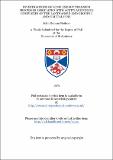Investigations of some energy transfer processes associated with acetylacetonate complexes of the lanthanoid and groups I and II metal ions
Abstract
Intermolecular energy transfer occurs between Tb(aa)₃.3H₂0 and Ln(aa)₃.3H₂O complexes (Ln = Pr, Nd, Sm, Eu, Dy, Ho or Er; aa = acetylacetonate) in n-butanol solution at 293K. Measurement of the decay time of the Tb³⁺ ⁵D₄level indicates that transfer occurs from this level to excited levels of the Ln³⁺ ions with bimolecular rate constants within the range 0.5 - 4.9 x 10⁵ dm³ mol s ⁻¹. Data from similar measurements on a mixed crystal EuxTb(1-x)(aa)₃.3H₂O and other considerations indicate that this is a very short range electron-exchange transfer. Similar measurements of the Tb³⁺ ion phosphorescence yield indicate the presence of a further intermolecular transfer process between a higher excited state of the Tb³⁺ complex and the added Ln³⁺ complexes. The Stern-Volmer Quenching constants vary from 11 dm³ mol⁻¹ for Ho and Sm to 110 dm³ mol⁻¹ for Pr. It is concluded that this transfer is unlikely to occur from either the ligand singlet or triplet levels and it is proposed that a higher Tb³⁺ level such as the ⁵D₃ may be involved in both inter- and intramolecular energy transfer. Intermolecular energy transfer between excited state Tb³⁺ ions in Tb(aa)₃.3H₂O and Ln³⁺ ions in Ln(aa)₃.3H₂O, where Ln = Eu and Sm, is shown to be markedly solvent dependent. It is proposed that the Tb³⁺ → Ln³⁺ energy transfer occurs in mixed metal dimers where the Tb-Ln distance is likely to be ca. 0.4 nm. The solvent dependent behaviour is related to the relative concentrations of monomeric and dimeric species in the various solvents. The rate controlling step in the intermolecular energy transfer is probably that, of monomer-dimer reaction which at 273K is of the order of 10⁵ dm³ mol⁻¹ s⁻¹. The activation energy of this reaction between Tb, Eu and Sm acetylacetonates is estimated to be ca. 23 kJ mol⁻¹. ¹H NMR spectra of Lu(aa)3.2H2O in several solvents are reported. The spectral profiles are temperature dependent in benzene and toluene solutions and the multiplicity of ligand methyl resonances is attributed to slow exchange between non-equivalent methyl groups in a dimeric structure. The temperature dependence in acetone solution is consistent with the presence of a monomer-dimer equilibrium with △H° = -28.2 ± 1.5 kJ mol⁻¹ and △S° = -74.5 ± 4.5 J K ⁻¹ mol⁻¹. The single ligand-methyland 3-H resonances in the' strongly coordinating solvents dimethyl sulphoxide and pyridine indicate the sole presence of solvated monomers. Previous proposals about the anomalous spectrum of Mg(aa)₂ in CDCl₃ are also discussed. The extremely low efficiency of the intermolecular enrgy transfer process in europium acetylacetonate compared with the corresponding terbium acetylacetonate is attributed to the presence of a charge-transfer excited state lying below the ligand singlet states. This is supported by the anomalous absorption spectrum of the Eu³⁺complex and the effects of added anions in other ligand systems. The phosphorescence spectra of the Group I and Group II metal acetylacetonates (Metal = Li, Na, K, Rb, Gs, Mg, Ca, Sr and Ba) have all been measured in solid Ethanol glass solutions at 77K and found to have profiles similar to that of Al(aa)₃. The phosphorescence decays are non-exponential and this behaviour is attributed to the presence of both coordinated and free acetylacetonate anion. Time resolved spectroscopy and other considerations indicate that the energies of the lowest excited ligand singlet and triplet states of the aa⁻ ion are, unlike the triplet state lifetime, little affected by coordination. Solvolysis is reported in ethanol solution which invalidates some previously-reported spectral parameters.
Type
Thesis, PhD Doctor of Philosophy
Collections
Items in the St Andrews Research Repository are protected by copyright, with all rights reserved, unless otherwise indicated.

